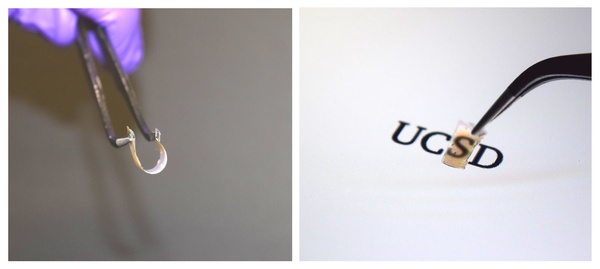|
engineers at the university of california san diego have created a thin, flexible near-perfect broadband absorber that can absorb more than 87 percent of near-infrared light (1,200-2,200 nanometers) and 98 percent of light at 1,550 nanometers, which is the wavelength of fiber optic communication, and is tunable to allow certain wavelengths through while absorbing others.

this new development could be used for thermally insulating coatings and more efficient solar cells.
(uc san diego)
according to a report on the uc san diego website, the absorber works through surface plasmon resonances, which is the collective movement of free electrons on the surface of metal nanoparticles when interacting with certain wavelengths of light.
the engineers created an absorber using semiconductor material than can be modified (doped) to have specific numbers of free electrons; in this case they chose a mix of zinc oxide and aluminum-doped zinc oxide. the article explained, “the materials were combined and structured in a precise fashion using advanced nanofabrication technologies in the nano3 cleanroom facility at the qualcomm institute at uc san diego.”
the material was placed one atomic layer at a time onto a silicon substrate, which created a series of nanotubes that had rings of zinc oxide and aluminum-doped zinc oxide. once the nanotube array was created it was then transferred to a thin, elastic polymer in order to create the absorber that is transparent in the visible wavelength.
the material can be tuned in any number of ways, from the gap between the tubes to the ratio of materials to the type of materials to the concentration of free electrons. it can also be used with any number of different substrates and scaled for large surfaces.
among the possible applications that the engineers outlined for this technology are transparent window coatings that are thermally insulating, coatings that make solar cells more efficient, and lightweight shields that block thermal detection.
the research was published in proceedings of the national academy of science. the abstract stated:
“broadband absorbers are essential components of many light detection, energy harvesting, and camouflage schemes. current designs are either bulky or use planar films that cause problems in cracking and delamination during flexing or heating. in addition, transferring planar materials to flexible, thin, or low-cost substrates poses a significant challenge.
“on the other hand, particle-based materials are highly flexible and can be transferred and assembled onto a more desirable substrate but have not shown high performance as an absorber in a standalone system.
“here, we introduce a class of particle absorbers called transferable hyperbolic metamaterial particles (thmmp) that display selective, omnidirectional, tunable, broadband absorption when closely packed. this is demonstrated with vertically aligned hyperbolic nanotube (hnt) arrays composed of alternating layers of aluminum-doped zinc oxide and zinc oxide.
“the broadband absorption measures >87% from 1,200 nm to over 2,200 nm with a maximum absorption of 98.1% at 1,550 nm and remains large for high angles. furthermore, we show the advantages of particle-based absorbers by transferring the hnts to a polymer substrate that shows excellent mechanical flexibility and visible transparency while maintaining near-perfect absorption in the telecommunications region.
“in addition, other material systems and geometries are proposed for a wider range of applications.”
|